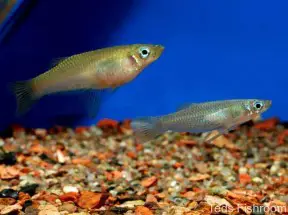Alfaro cultratus
Knife Livebearer, Messerschwanzkärpfling (DE)
SynonymsTop ↑
Petalosoma cultratum Regan, 1908; Petalosoma amazonum Regan, 1911; Alfaro acutiventralis Meek, 1912
Etymology
Alfaro: named for Anastasio Alfaro (1865-1951), who was Director of the National Museum of Costa Rica and “the best known scientist of the Republic” at the time when this genus was described.
cultratus: Latin term for ‘knife-shaped’, in reference to the shape of the lower caudal-fin lobe in this species.
Classification
Order: Cyprinodontiformes Family: Poeciliidae
Distribution
Costa Rica, Nicaragua and Panama. Type locality is “Río Iroquois, Costa Rica”.
Habitat
Is found in rivers, streams, ditches and backwaters in areas of both slow and moderate flow.
Maximum Standard Length
75 mm.
Maintenance
It’s most at home in a planted aquarium. Provide areas of dense vegetation, along with some open areas for swimming. Other decor can consist of twisted roots and smooth rocks. Some floating vegetation will also be appreciated by this surface dweller.
Water Conditions
Temperature: 24 – 28 °C
pH: 6.0 – 8.0
Hardness: 90 – 357 ppm
Diet
Unfussy. Offer a varied mix of dried, frozen and live foods.
Behaviour and CompatibilityTop ↑
Can be aggressive, especially towards conspecifics. Best kept in a species tank or with robust fish of a similar size.
Sexual Dimorphism
The male possesses a gonopodium and extended ventral fins, while the female is larger and plumper.
Reproduction
An easily-bred live bearer. If conditions are to their liking young will be produced regularly. Fry should be removed to a separate tank as you notice them and fed on microworm or powdered flake. Between 20-100 fry may be produced in a single brood.
NotesTop ↑
This is an exceptionally hardy and adaptable species. It’s not an especially common fish in stores, but is quite widely available in hobbyist circles. The common name arises from the row of modified, paired scales that form a keel running from the base of the anal fin to the caudal fin.



